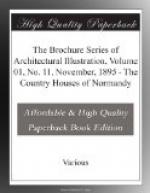[Illustration: LXXXIII. Manoir at Archelles, Normandy.]
The exercises themselves may be described as a species of design by description or by dictation. The attempt is made, by indicating the conditions under which a given piece of work was executed, to present to the student the same problem that the workman of old was called upon to solve. The student can then compare his own solution of it with the one that has come down to him, thus receiving correction and guidance in his work from the hand of the master. It is plain that the special excellencies of the original monument are likely to reveal themselves with fresh distinctness, and to find special sympathy and appreciation in the mind of one who has striven, however unsuccessfully, to solve the same problem.
An example or two taken from widely different fields will suffice to illustrate this. In studying vaulting, we once got so far as to understand how oblong vaults were thrown across a nave, while square vaults covered the aisles. A class of fifteen or twenty students were then asked to find out how a semi-circular or polygonal apse could be added to a choir roofed on this system. In the course of a couple of hours’ figuring I found that they had worked out among them all the five solutions of this problem, which in the Middle Ages it took one or two hundred years to develop. This was very encouraging. At another time they were given a somewhat minute description of four pilaster capitals from Blois or Chambord, and they made thumb-nail sketches on the spot, according to their interpretation of the description. The next day photographs and drawings of a dozen or twenty other such capitals were given them, so that they might understand the fashion of the time, and they were told to draw out their sketches on a larger scale. The result was fifteen or twenty sets of capitals, all showing the same four motives, but differing in a most interesting way, according to the personal differences of taste and skill on the part of the designers.
On another occasion the First-year class, after their studies in Egyptian and Assyrian architecture, made a dozen or twenty restorations of Solomon’s Temple, according to the description in the Book of Kings. The drawings they produced showed considerable fertility of invention, especially in the designs for Jachin and Boaz, and the whole series together seemed to be quite as creditable and as reasonable as most of those which have from time to time been put forth by the learned.
This practice in historical design we believe to be founded on sound theoretical principles. To regard a work of art as far as possible from the point-of-view of the artist is, indeed, the first principle of fair and intelligent criticism. To foster the individuality and personal initiative of a pupil by bringing authority to bear upon him in a way of correction at the end of his task, and guidance and suggestion at the beginning,




